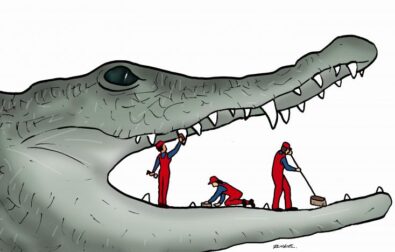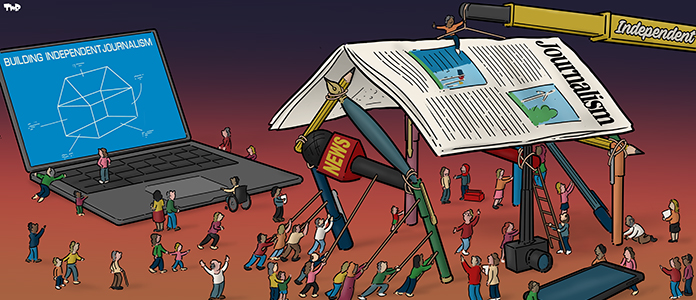The EU’s Common Agricultural Policy accounts for almost 40 percent of EU budget spending. Between 2014 and 2020, out of the total of 1.1 trillion euro spent by the EU, more than 400 billion went to support European farmers and agriculture. The main objectives of the CAP can be summarised with a few simple points: to support farmers and agriculture (an inherently precarious sector, with fluctuating prices and shifting production processes), to improve agricultural productivity, and to ensure a stable supply of affordable food while allowing European farmers to maintain a decent lifestyle. All this, while also safeguarding the environment.
The EU imposes certain conditions on the distribution of subsidies, such as “cross-compliance” and “greening”, which seek to encourage best practices in respect to the environment, animal welfare and product quality. Some of these consist in the protection of the most environmentally sensitive lands, the reduction of fertilizer use, afforestation, or the promotion of organic farming.
Given the amount of money allocated to the CAP, it is often the subject of controversy. For example, the fact that 80 percent of funding ends up in the pockets of a mere 20 percent of farmers. This time round, the problem has nothing to do with money or its distribution, but rather the effectiveness of the measures financed by the CAP.
Lots of funding, poor results
Between 2014 and 2020, the CAP allocated over 100 billion Euro to measures intended to combat climate change. This was more than a quarter of its total budget and 50 percent of total EU spending for environmental policies. A report published in June by the European Court of Auditors reveals how these funds failed to produce significant results in terms of reducing agricultural greenhouse emissions, which remained almost stable over the past 10 years. In other words: half of the EU budget earmarked for tackling climate change has not produced concrete results.
Between 1990 and 2010, greenhouse gas emissions from agriculture had fallen by 25 percent, in line with the targets set by the 1997 Kyoto Protocol. In 2015, the EU signed the Paris Agreement and pledged to reduce emissions by 40 percent by 2030. The Commission then decided to raise this percentage to 55 percent and to go even further, targeting "zero-emissions" by 2050. The 2014-2020 PAC was designed with the intention of reducing emissions, but without specifying a clear-cut target.
What went wrong?
In the European Union, food production is currently responsible for 13 percent of greenhouse gas emissions, while forecasts predict it could exceed 50 percent in 2050. Within this 13 percent, half of CO2 or equivalent gas emissions are produced by livestock, and the other half by nutrients used in agricultural soil (36 percent) and land use (14 percent).
According to the Court of Auditors, the only effective strategy to reduce greenhouse gas emissions from livestock farming is to reduce consumption of products derived from animals and their production. Since 2014, this has not happened - in fact, the consumption of animal products such as eggs and poultry has increased by between 10 and 15 percent. This is not helped by the fact that the CAP has yet to implement any measures aimed at discouraging consumption and production, but, on the contrary, funds the promotion of animal products on the market.
Over the past decades, technological progress has contributed to a reduction in emissions, but in many cases it has also led to lower production costs and the consequent growth of livestock farming, thus cancelling out any positives. The same story plays out in agriculture. Another reason specific to cattle farming that explains steady production is that about half these farmers’ income comes from direct payments, granted in proportion to their productivity. This tends to disincentivise any drop in production.
Interesting article?
It was made possible by Voxeurop’s community. High-quality reporting and translation comes at a cost. To continue producing independent journalism, we need your support.
As for the other sectors, the results are equally disappointing. Emissions derived from the use of nutrients in agricultural soil (mainly fertilizers and manure) increased by almost 5 percent between 2010 and 2019. Here again the only solution would be to adopt more innovative practices, which are not given sufficient support by the CAP compared to other, less effective methods (such as organic farming, which according to the Court of Auditors has an unclear impact on emissions reduction).
A similar argument applies to atmospheric emissions from land use, which have remained almost stable since 2010. When soils are drained, the organic materials they contain emit more or less greenhouse gases depending on various factors: type and intensity of cultivation, type of soil, moisture content, etc. Soils richer in organic matter, such as peatlands, are particularly problematic as their cultivation produces about 20 percent of emissions derived from agriculture in the European Union while representing only 2 percent of used land. Some Member States have promoted initiatives to protect or rehabilitate such lands – sometimes using CAP funds – but no ad hoc measure has been established at the European level.
Thus, the overarching problem lies in the fact that until now the EU has funded ineffective, or even un-implemented, measures. Nevertheless, the Court of Auditors declares that solutions are just at hand. For example, if direct payments to farmers were allocated in return for reduced greenhouse gas emissions, a 17 percent cut in emissions would be achieved.
The new CAP
This time around, the controversy is rather obvious. Since the CAP is one of the few truly “common” European policies and a pillar of Brussels’ political activity, one would expect the EU to act hand in hand with the hard line on environment policies it has pursued in recent years.
Especially after the introduction of the Green Deal, European governments and institutions began fierce discussions about how to reduce emissions from agriculture. Such debates even forced the postponement of the new CAP from 2021 to 2023. Last May, the parties involved in the negotiations were once again unable to find common ground, clashing precisely on the matters relating to the amount of funds being allocated to environmental policies.
A few days ago, however, the European Parliament and Member States governments finally reached an agreement on how to spend the 270 billion earmarked for the new CAP until 2027. European institutions have called the agreement "simpler, fairer and greener", while environmental associations are calling it a case of "big, huge greenwashing". The latter believe the new measures are yet again inadequate, and in many cases too flexible, not mandatory, vague, unchanged, non-existent, or even softened.
The new CAP will have to be approved by European agriculture ministers and the European Parliament, but if it enters into force, it will result in greater flexibility for individual countries, being able to decide how to spend subsidies with less control from Brussels. However, they are required to allocate at least 25 percent of direct payments (the largest share of funding) to so-called “eco-schemes”, and at least 35 percent of rural development funds to projects aimed at safeguarding the environment and promoting animal welfare.
According to a document published in May by a group of environmental NGOs, several measures are likely to be ineffective. Intensive farming, for example, could continue to receive a lot of funding, and "eco-schemes" aimed at promoting animal welfare risk becoming subsidies that produce no tangible results in terms of emissions reduction. Other meaningful measures will not be mandatory, such as those favouring the reduction of the use of nutrients for the soil, while others are mandatory but considered too weak. For example, negotiations seem to have weakened rules safeguarding organic soils and peatlands, as well as those on the restoration of natural areas and the use of certain types of pesticide. Moreover, there will be no fixed budget for programmes promoting biodiversity, in addition to the many other issues highlighted in the report.
So, the new CAP is set to be even more controversial than the previous one. The European Union is now getting to grips with the Green Deal and its implementation. Clearly, it’s too early to judge, but we do know one thing: no matter how much money is spent on combating climate change, it’s all a waste if the measures are not effective.












